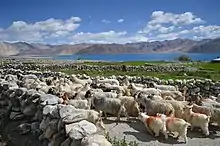Changthangi
The Changthangi or Ladakh Pashmina is a breed of cashmere goat native to the high plateaux of Ladakh, India. The cold temperatures in the region are the primary factor in the growth of the fine pashmina grade of cashmere wool for which they are reared.[4] It is also used as a pack animal and for meat.[3]:369
 | |
| Conservation status | |
|---|---|
| Other names |
|
| Country of origin | India |
| Distribution | Ladakh |
| Use | |
| Traits | |
| Weight | |
| Height |
|
| Skin colour | white or light brown[3]:369 |
| Wool colour | usually white, also black, brown or grey[3]:369 |
| |
This breed of cashmere goat grows a thick, warm undercoat which is the source of Kashmir pashmina wool - the world's finest cashmere measuring between 12-15 microns in fiber thickness. These goats are generally domesticated and are reared by nomadic communities called the Changpa in the Changthang region of Ladakh.[5] The Changpa communities are a sub-sect of the larger Buddhist Drokpa community in northern Indian union territory of Ladakh.
They survive on grass in Ladakh, where temperatures plunge to as low as −20 °C (−4.00 °F).[6] These goats provide the wool for Kashmir's famous pashmina shawls. Shawls made from Pashmina wool are considered very fine, and are exported worldwide.
The Changthangi goats have revitalized the poor economy of Changthang, Ladakh where the wool production generates more that $8 million a year.[7]
Noori, the world's first cloned Pashmina goat, was cloned at the Faculty of Veterinary Sciences and Animal Husbandry of the Sher-e-Kashmir University of Agricultural Sciences and Technology of Kashmir (SKUAST) in Shuhama, 25 km east of Srinagar, on 15 March 2012.
Physical features

The changthangi has a double coat, consisting of a thick undercoat and a dense, slightly wavy or straight outer coat. Its hair is usually white. Its body is of medium size, generally between 22 and 26 inches, in proportion to its height. The horns are rounded and always move upward. The average lifespan of this goat is 10 to 12 years.
References
- Barbara Rischkowsky, D. Pilling (eds.) (2007). List of breeds documented in the Global Databank for Animal Genetic Resources, annex to The State of the World's Animal Genetic Resources for Food and Agriculture. Rome: Food and Agriculture Organization of the United Nations. ISBN 9789251057629. Accessed January 2017.
- Breed data sheet: Changthangi / India (Goat). Domestic Animal Diversity Information System of the Food and Agriculture Organization of the United Nations. Accessed April 2020.
- Valerie Porter, Lawrence Alderson, Stephen J.G. Hall, D. Phillip Sponenberg (2016). Mason's World Encyclopedia of Livestock Breeds and Breeding (sixth edition). Wallingford: CABI. ISBN 9781780647944.
- Newey, Andrew (2 January 2020). "Pashmina goat herders struggle against climate change". CNN Style. Retrieved 2 January 2020.
- Misra, R. K.; Singh, B.; Jain, V. K. (1 February 1998). "Breed characteristics of Changthangi pashmina goat". Small Ruminant Research. 27 (2): 97–102. doi:10.1016/S0921-4488(97)00033-3. ISSN 0921-4488.
- "Kashmir Pashmina goats face death in icy Himalayas". Reuters. 6 February 2008. Retrieved 2 January 2020.
- Bhattacharya, T.K.; Misra, S.S.; Sheikh, F.D.; Kumar, P.; Sharma, A. (2004). "Changthangi Goats: A rich source of pashmina production in Ladakh". Animal Genetic Resources Information. 35: 75–85. doi:10.1017/S1014233900001826.
